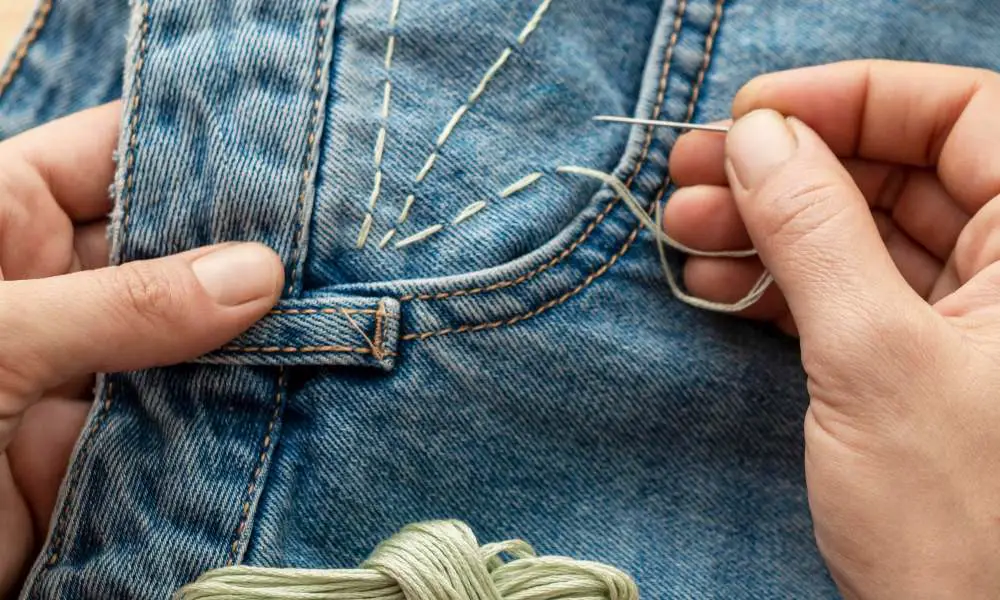Hemming jeans without a sewing machine is a simple and cost-effective solution for those who want to achieve a professional look without the hassle of complicated equipment. This straightforward guide will lead you through each step, guaranteeing a flawless fit for your jeans.
- Gather the necessary materials
- Prepare the jeans for hemming
- Measure and mark the desired length
- Apply fabric adhesive or fusible web
- Fold and iron the hem
- Secure the hem with fabric glue or no-sew tape
Are you tired of tripping over those long, frayed jean hems? Or perhaps you’ve found the perfect pair, but they’re just a tad too long?Fret not because we’ve got you covered with this foolproof method for hemming jeans without a sewing machine.
Understanding the Basics
Before we delve into the nitty-gritty of hemming jeans sans sewing machines, let’s take a moment to understand the fundamentals. Hemming is the process of folding and securing the raw edge of a fabric to prevent fraying and achieve a polished, finished look. Traditionally, this is done with a sewing machine, but fear not, dear reader, for we shall conquer this task with a few clever tricks and a steady hand.
The Original Hem
Depending on the jeans you’re working with, you may encounter an original hem. This is the factory-finished hem that came with your jeans. If the original hem is intact and you simply need to shorten the length, you can follow the same steps outlined below. However, if the original hem is distressed or damaged, it’s best to remove it before proceeding.
To remove the original hem, carefully use a seam ripper or sharp scissors to snip the stitches holding the hem in place. Once the hem is detached, you’ll have a clean, raw edge to work with.
Gathering the Necessary Materials
Before we dive into the process, let’s ensure you have everything you need. Here’s a quick checklist:
- Your jeans
- Scissors or a rotary cutter
- Ruler or measuring tape
- Iron and ironing board
- Fabric adhesive, fusible web, or no-sew hem tape
- Fabric glue (optional)
Preparing the Jeans for Hemming

Begin by wearing the jeans and deciding on the preferred length. Next, turn them inside out and give them a good press, ensuring a crisp, wrinkle-free surface. This step is crucial, as any creases or wrinkles can affect the accuracy of your measurements and the final look of the hem.
Measuring and Marking the Desired Length
Employ a ruler or measuring tape to gauge the preferred length starting from the bottom of the leg, marking it with chalk or a fabric pencil. Be sure to account for the hem allowance, typically 1-2 inches. This extra fabric will be folded over to create the new hem.
For example, if you want your jeans to be 30 inches long and planning a 1.5-inch hem allowance, mark the fabric at 31.5 inches from the bottom of the leg.
Creating the New Hem
Now that you’ve prepared the jeans and marked the desired length, it’s time to get creative and transform those raw edges into a polished, professional-looking hem.
Applying Fabric Adhesive or Fusible Web
One of the easiest and most effective methods for hemming jeans without a sewing machine is fabric adhesive or fusible web. These products create a temporary bond that holds the fabric in place, allowing you to create a crisp, even hem.
Spread a fine coat of fabric adhesive or fusible web on the underside of the fabric, following along the designated hemline. Adhere closely to the product guidelines for best outcomes. Some products may require ironing the adhesive or web to activate the bonding process.
Folding and Ironing the Hem
Gently fold the fabric along the indicated line, guaranteeing a neat crease. Press the folded hem with a hot iron, allowing the adhesive to bond or the fusible web to adhere correctly. This step is crucial, as is creating a sharp, defined line for your new hem.
If using a fusible web, follow the manufacturer’s instructions regarding temperature settings and pressing times to ensure the best possible bond.
Securing the Hem with Fabric Glue or No-Sew Tape
For added durability, you can apply a line of fabric glue or no-sew tape along the folded edge of the hem. This extra step helps to reinforce the bond and prevent the hem from unraveling over time.
Carefully apply the glue or tape, pressing firmly to ensure proper adhesion. Ensure it is fully dried before wearing your newly hemmed jeans.
Alternative Hemming Methods
While fabric adhesive and fusible web are excellent options, you can try a few other techniques for hemming jeans without a sewing machine.
Hemming Tape
Hemming tape is a double-sided adhesive tape designed explicitly for hemming garments. It’s easy to use and creates a strong, long-lasting bond. Apply the tape to the fabric’s underside along the hemline, fold the fabric, and then use a hot iron to activate the adhesive.
Fabric Stiffener or Liquid Starch
For a more temporary solution, you can use fabric stiffener or liquid starch to create a crisp, structured hem. Simply apply the stiffener or starch to the wrong side of the fabric along the hemline, fold the fabric over, and press with a hot iron. This method works best for lightweight fabrics and is ideal for a quick fix for a night out or a special occasion.
Frequently Asked Questions
Can I hem flared or tapered jeans without a sewing machine?
Absolutely! The techniques outlined in this guide work for all types of jeans, including flared, tapered, and straight-leg styles. The key is to measure and mark the desired length accurately, taking into account the unique shape of the leg opening.
How do I prevent the hem from unraveling or fraying?
While fabric adhesive, fusible web, and hemming tape provide a good amount of stability, you can further reinforce the hem by applying a line of fabric glue or no-sew tape along the folded edge. This extra step helps to prevent fraying and unraveling over time.
Can I use these methods to hem dress pants or other garments?
Certainly, you can utilize these methods for a range of garments, such as dress pants, skirts, and curtains. The principles of measuring, folding, and securing the hem are universal, regardless of the fabric type or garment.
***
This simple technique gives you perfectly tailored jeans without a sewing machine. Embrace your newfound hemming skills and let those stylish, well-fitting jeans take center stage! Are you ready to bid farewell to frumpy, ill-fitting denim and embrace the joy of perfectly hemmed jeans?
***
Main image: freepik




